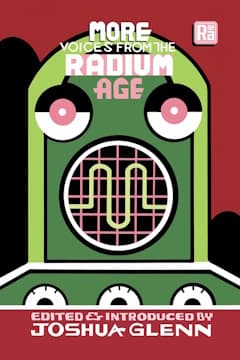
Mores Voices from the Radium Age edited and introduced by Joshua Glenn
(MIT Press, 2023)
Reviewed by Andy Sawyer
Joshua Glenn’s concept of the “Radium Age”—that period (roughly the first three decades of the twentieth century) before sf’s post-1935 “Golden Age”, points away from what Hugo Gernsback was pointing to when he identified, in 1926, the “new” wave of writing he dubbed “scientifiction”—towards a wider field. Glenn’s alternative, “proto-sf” is, for me, less happy, because it implies even more of a sweeping-up of material which we can now identify as sf rather than the kind of iconic wonder-story such as Gulliver’s Travels, or post-Copernican moon-voyages, which later writers drew upon. Perhaps it is safer to simply take the nine stories here, published between 1901, and 1926 and ask what they bring to us.
More Voices is a varied collection, although Wells’s “The Land Ironclads” is much-reprinted, and Glenn flags it as a “prediction” of tank warfare which is less its significance than the way it undermines assumptions on how to make war. While the first story, George C. Wallis’s “The Last Days of Earth” suffers from the way its two characters talk ponderously at rather than to each other, its picture of a dying Earth and the two humans left alive until their last chance to depart is vivid. It becomes powerfully poignant when we discover that another couple, and another “Red Sphere” remain to challenge their role as “designated survivors”. Perhaps not the best story in the collection, but possibly the most interesting, is that by the Russian Symbolist Valery Bryusov. “The Republic of the Southern Cross”, published 1907 and translated into English 1918, comes from a very different current of early sf than English-language “scientific romances”; fusing “cosmic”, political and mystical ideas which swirled around the genesis of the Russian Revolution. As in Zamyatin’s better-known We, Bryusov’s utopia/dystopia is profoundly ambiguous, a planned state in Antarctica where “[t]hough appearing to have liberty, the life of the citizens was standardised even to the most minute details”. In the capital Zvezdny (Star City) a disease (“contradiction”) appears and spreads, at first manifesting itself in comic fashion—saying “no” instead of “yes”, transport conductors handing out money instead of collecting fares, orchestral musicians interrupting performances with dissonant passages—but rapidly spreading into chaotic, macabre and violent scenes, and social collapse.
So far: the end of the world, technological advances, and utopian/dystopian anxieties. “The Third Drug” is one of E. Nesbit’s scientific/gothic tales, with the Jekyll/Hyde flavour heightened and darkened by the way the “mad scientist’s” experiment is presented. Wounded by street-thugs in Paris, a young man is rescued by a doctor who gives him a series of drugs. The second (taken orally) heightens his physical sensibility to the point of agony. The third (injected) gives him superhuman knowledge. The experiment succeeds—but Roger has had to be tied to his seat before the injection to ensure his immobility while the drug takes effect. The doctor takes the second drug and calls for Roger to inject the third. Roger, however, cannot break his bonds. A thought-provoking twist ends the story.
Algernon Blackwood’s “A Victim of Higher Space” oscillates between “science” and “mysticism” in a story which also combines weird fiction and slapstick comedy. The unfortunate Mudge, triggered by snatches of music into entering a Higher Space in which people and objects can be seen “in their true and complete shapes”, is one of the patients of Blackwood’s occult-detective, John Silence. This is perhaps not one of Silence’s most successful cases, but it is one which highlights the instability of reality. A. Merrit’s “The People of the Pit” and George Allan England’s “The Thing From—‘Outside’” are similar examples of pulp sf/horror intrusions; one a Lovecraftian discovery of a hellish “pit” inhabited by beings “infinitely malignant, infinitely horrible, infinitely ancient” and the other a version of Algernon Blackwood’s “The Wendigo”, similarly set in the wastelands of the Canadian forest. As Glenn notes, the latter story cites Charles Fort, the collector of anomalies who suggested, at one point, that there are forms of life to whom we are no more than ants. The being which kills most of the party and instils in Jandron a horror so profound that he insists his wife not wear a wedding-ring may be one such.
Following these “traditional” pulps, two stories round off the collection most effectively. May Sinclair’s “The Finding of the Absolute” is another exploration of reality by a writer whose supernatural fiction often played with “hyperspatial” ideas. In the Afterlife, Spalding encounters his ex-wife and her lover, who tell him that one does not “qualify” for heaven simply by following a code of ethics, and once there, one can create one’s own environment by an act of will. Further explanations are offered by the philosopher Immanuel Kant, who introduces him to the concept of “cubic time”. “The Veiled Feminists of Atlantis” by the once immensely popular Booth Tarkington is on one level a story about male anxiety about female equality, but its plot interesting echoes directly more contemporary debate. The Atlantean “feminists” achieved equal, in some cases superior, status to men by a process which in part meant the rejection of wearing veils. Once this status is achieved, some of the women wish to resume the practice—a decision rejected by the men who now feel threatened by it. It’s a slight, even trite story, but the issue it hinges upon is an actual, live, issue today.
All the stories, then present a fascinating glance into the anxieties of the early twentieth century, existential as well as scientific. It’s a thoughtfully put-together collection: some authors will certainly be familiar to many readers, but the Bryusov and Sinclair contributions add extra value.
Review from BSFA Review 22 - Download your copy here.
